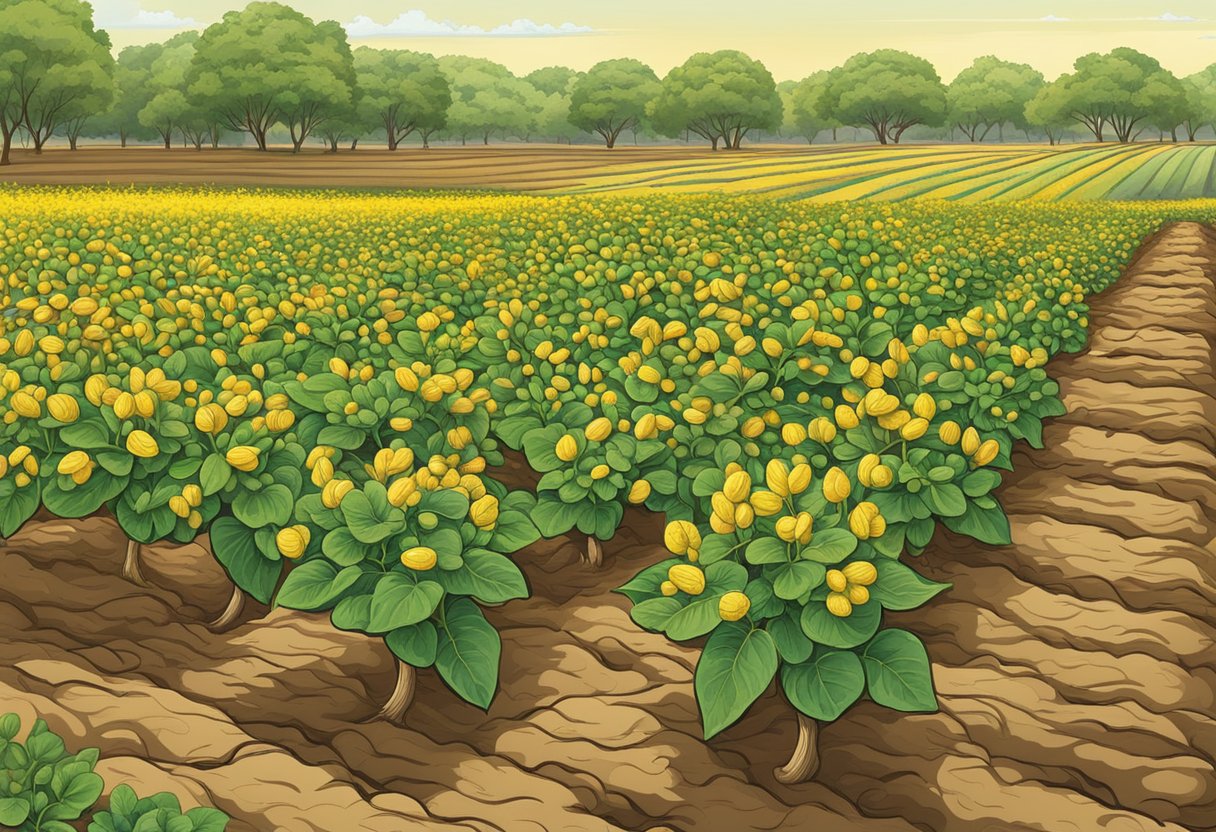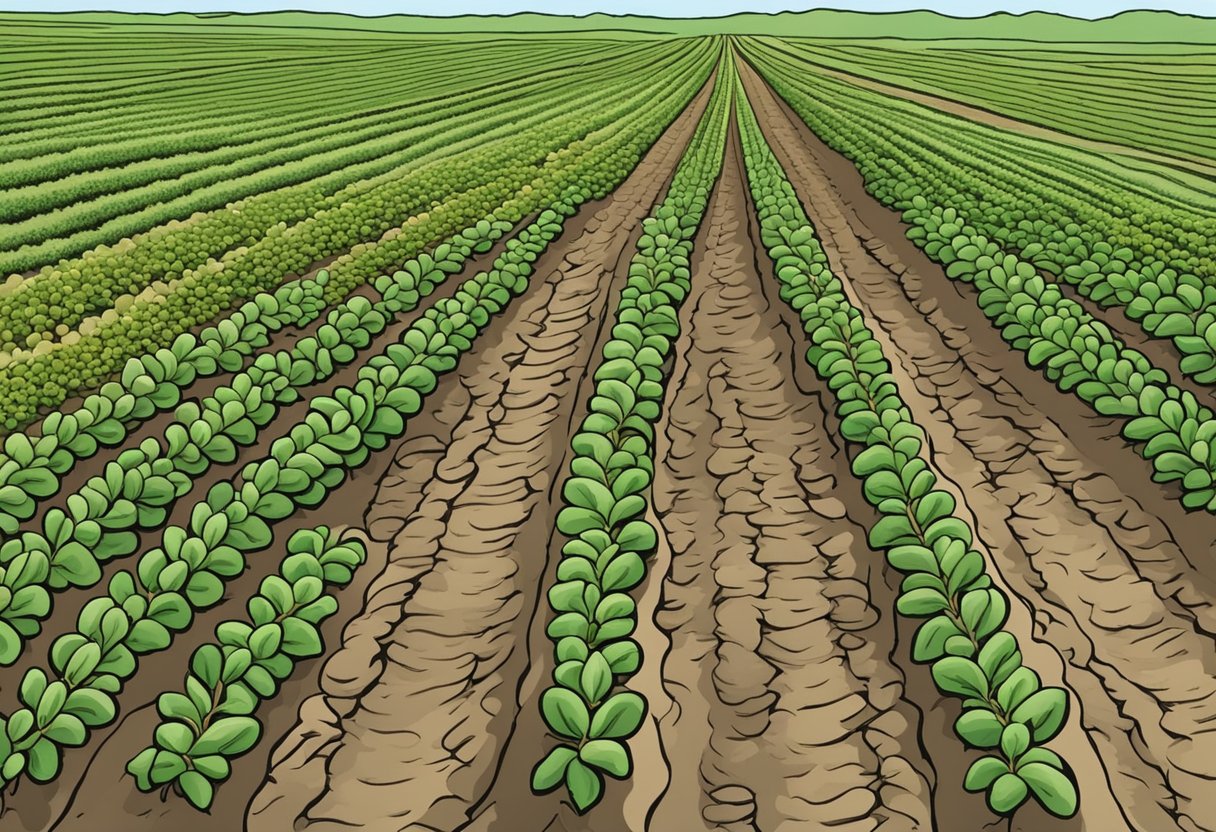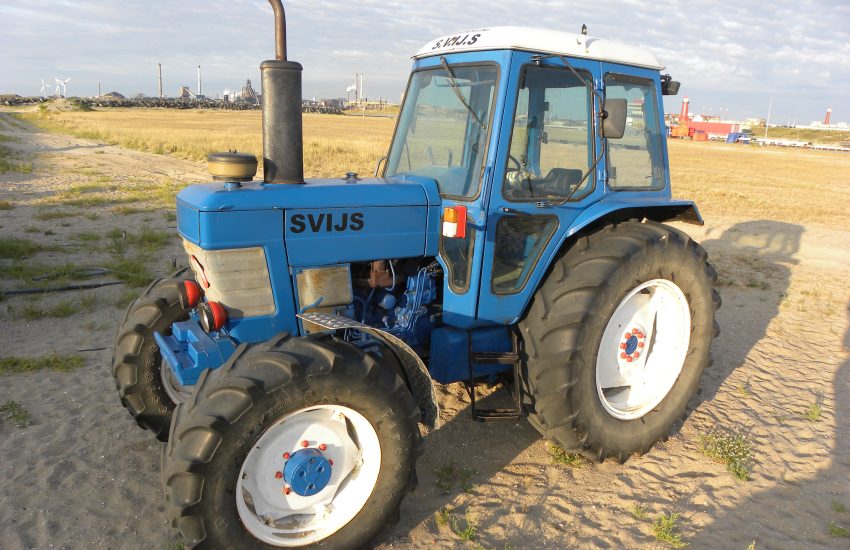How Do Peanuts Grow: A Comprehensive Guide
Peanuts, also known as groundnuts, are a popular snack and ingredient in many cuisines. However, have you ever wondered how peanuts grow? Peanuts are legumes and not nuts, and they grow underground. In this article, we will explore the process of peanut growth, from planting to harvest.

The first step in growing peanuts is planting. Peanuts grow best in warm temperatures and sandy soil. Farmers typically plant peanuts in rows, with seeds placed about 2 inches deep and 6 inches apart. Once planted, the seeds will germinate within 7-10 days. As the peanut plant grows, it will develop yellow flowers, which eventually turn into pods. Each pod contains two to three peanut seeds, which will mature over the course of several months.
As the peanut seeds mature, they will begin to grow underground. This is because the peanut plant sends out pegs, which are thin stems that grow down into the soil. The pegs will eventually reach the ground and burrow into it, where the peanut seeds will develop and mature. Once the peanuts are fully matured, the farmer will harvest them by uprooting the entire plant and shaking off the soil. The peanuts will then be dried and sorted before being sold or used for further processing.
Understanding the Peanut Plant
Botanical Profile
The peanut plant, scientifically known as Arachis hypogaea, is an annual legume that belongs to the family Fabaceae. This plant is native to South America, but it is now widely cultivated in different parts of the world, including Africa, Asia, and North America.
The peanut plant grows up to 50 cm tall and has a deep taproot that can reach up to 1.5 meters in length. It produces yellow flowers that self-pollinate and eventually develop into pods that contain the peanuts.
Varieties of Peanuts
There are three main varieties of peanuts: runner, Spanish, and Valencia. The runner variety is the most commonly grown type and accounts for about 80% of the world’s peanut production. It is known for its uniform size and shape, and it is often used for making peanut butter. The Spanish variety has a smaller kernel and a reddish-brown skin. It is commonly used for making snacks such as roasted peanuts and peanut brittle. The Valencia variety has a sweet flavor and a bright red skin. It is often used for making gourmet peanut products such as peanut oil and candy.
Each variety of peanut has its own unique characteristics, and farmers choose the variety that is best suited for their growing conditions and market demands.
In conclusion, understanding the peanut plant is crucial for successful peanut cultivation. By knowing the plant’s botanical profile and the different varieties available, farmers can make informed decisions that can lead to a successful harvest.
Preparation for Planting

Soil Requirements
Before planting peanuts, it is important to ensure that the soil is well-drained and rich in organic matter. Peanuts grow best in sandy soil with a pH level between 5.8 and 6.2. The soil should also be free from any rocks or debris that could impede root growth.
To prepare the soil for planting, the area should be cleared of any weeds or grass. The soil should then be tilled to a depth of 8-10 inches to loosen the soil and promote better root growth. Adding organic matter such as compost or well-rotted manure can also help improve soil fertility and texture.
Choosing the Right Time
Peanuts require a long growing season of at least 120 to 150 frost-free days. In order to ensure a successful harvest, it is important to plant peanuts after the last frost in the spring. The ideal soil temperature for planting peanuts is between 65 and 70 degrees Fahrenheit.
Peanuts also require full sun to grow properly. It is important to choose a planting location that receives at least 6 to 8 hours of direct sunlight per day. This will help ensure that the plants receive enough energy to produce healthy and abundant crops.
By following these guidelines for soil preparation and planting timing, growers can ensure a successful peanut harvest.
Planting Process

Sowing Seeds
The first step in growing peanuts is to sow the seeds. Peanut seeds should be planted in sandy soil at a depth of 1-2 inches. The seeds should be spaced about 4-6 inches apart in rows that are about 30-36 inches apart.
It is important to ensure that the soil is moist and well-drained before planting the seeds. To improve the soil quality, aged compost or potting soil can be added to the soil.
Optimal Growth Conditions
Peanuts grow best in warm and humid conditions. The ideal temperature range for peanut growth is between 70-90°F. The humidity level should be around 50-70%.
To ensure optimal growth, it is important to provide the plants with adequate nitrogen and fertilizer. The plants should be watered regularly to maintain moisture in the soil. Mulch can also be used to help retain moisture in the soil and prevent weed growth.
In summary, planting peanuts involves sowing the seeds in sandy soil at the right depth and spacing, providing optimal growth conditions such as moisture, humidity, and nutrients, and using mulch to help retain moisture and prevent weed growth.
Peanut Plant Care

Growing peanuts requires proper care and attention to ensure a healthy and bountiful crop. This section will cover the essential aspects of peanut plant care, including watering and mulching, as well as weed and pest management.
Watering and Mulching
Peanuts require consistent moisture throughout their growing season. They should be watered deeply and regularly, especially during dry spells. However, overwatering can lead to root rot and other problems, so it’s important to find a balance.
Mulching can help retain moisture in the soil and prevent weeds from growing. A layer of organic matter, such as straw or leaves, should be spread around the plants, being careful not to cover the stems. This will also help regulate soil temperature and prevent erosion.
Weed and Pest Management
Weeds compete with peanuts for nutrients and water, so it’s important to keep them under control. Hand weeding can be effective, but it’s also time-consuming. Herbicides can be used, but they should be applied carefully to avoid damaging the peanut plants.
Pests, such as aphids, can also be a problem for peanut plants. Regular scouting and monitoring can help detect pests early on. Insecticidal soaps or oils can be used to control aphids, but care should be taken to avoid harming beneficial insects.
In conclusion, proper care of peanut plants involves consistent watering and mulching, as well as effective weed and pest management. By following these guidelines, growers can ensure a healthy and productive peanut crop.
The Growth Cycle
Peanuts are a legume crop, and their growth cycle is similar to that of other legumes. Understanding the growth cycle of peanuts is essential for successful cultivation.
From Flowering to Pegging
The growth cycle of peanuts begins with the emergence of seedlings from the soil. The seedlings develop stems and foliage, and after a few weeks, they begin to flower. The flowers are yellow and have five petals. The petals fall off after a day or two, leaving behind a small peg.
The peg grows down into the soil, where it develops into an ovary. The ovary is pollinated by wind or insects, and it develops into a peanut pod. The peanut pod continues to grow underground, and it is attached to the peg.
Developing and Maturing Pods
The peanut pods take about 100 to 120 days to mature. During this time, the pods grow larger and fill with peanuts. The pods are ready for harvesting when the foliage turns yellow and the stems begin to dry out.
The growth of peanuts is affected by various factors, including temperature, moisture, and soil nutrients. Proper management of these factors is essential for a successful peanut crop.
In conclusion, understanding the growth cycle of peanuts is crucial for successful cultivation. By providing the necessary conditions for growth and maturity, farmers can ensure a bountiful harvest of high-quality peanut pods.
Harvesting Peanuts

Determining Harvest Time
Farmers have to determine the right time to harvest their peanut crop. The maturity of the peanut pods is the key factor in deciding when to harvest. The ideal time to harvest peanuts is when the pods have reached their maximum size, but the kernels inside have not yet fully matured. The pods should be firm to the touch and have a yellowish color. Farmers can also check the maturity of the peanuts by digging up a few plants and examining the pods for the kernel development.
Gathering and Drying
Once the peanuts are ready for harvest, farmers use a combine to pull the vines out of the ground and shake the peanuts loose from the plants. The peanuts are then collected in a hopper and transported to a drying facility.
At the drying facility, the peanuts are spread out on a conveyor belt and heated to remove any excess moisture. The drying process usually takes several days, and the peanuts are constantly monitored to ensure they are not over-dried. Over-drying can cause the peanuts to become brittle and reduce their quality.
After the peanuts are dried, they are sorted and graded based on their size, shape, and color. The highest quality peanuts are sold for human consumption, while lower quality peanuts are used for animal feed or industrial purposes.
In conclusion, harvesting peanuts requires careful timing and attention to detail. Farmers must wait until the pods have reached maturity before using a combine to gather the peanuts. Once harvested, the peanuts must be dried and sorted to ensure they meet the high standards of the industry.
Post-Harvest Processing

Cleaning and Storing
After harvesting, the peanuts need to be cleaned and stored properly to ensure their quality. The first step is to remove any debris or foreign objects from the peanuts, which is usually done using a series of screens and blowers. Once the peanuts are clean, they are stored in a cool, dry place to prevent spoilage.
Proper storage is crucial for maintaining the quality of the peanuts. If stored incorrectly, the peanuts can become moldy or rancid, which can affect their flavor and nutritional value. It is recommended that peanuts be stored in airtight containers in a cool, dry place, away from direct sunlight.
Uses of Harvested Peanuts
Harvested peanuts can be used for a variety of purposes. Raw peanuts can be consumed as a snack or used in cooking, while roasted peanuts are a popular snack food. Peanut butter is another popular use for peanuts, and is made by grinding roasted peanuts into a smooth paste.
In addition to food products, peanuts can also be used for other purposes. Peanut shells can be used as animal feed or as compost, while the oil extracted from peanuts can be used for cooking or as a fuel source.
Overall, proper post-harvest processing is essential for maintaining the quality of harvested peanuts. By cleaning and storing the peanuts properly, and utilizing them for various purposes, farmers can maximize the value of their crop.
Nutritional Benefits

Peanuts are a nutritious food that can provide several health benefits. They are a good source of protein, fiber, and several essential vitamins and minerals. In this section, we will discuss the health aspects of peanuts and their role in the diet.
Health Aspects of Peanuts
Peanuts are a good source of protein, containing about 7 grams per ounce. They also contain healthy fats, including mono- and polyunsaturated fats, which can help to reduce the risk of heart disease. Peanuts are also a good source of fiber, which can help to promote digestive health and reduce the risk of certain diseases.
In addition to their protein and fiber content, peanuts are also a good source of several essential vitamins and minerals. They are particularly high in niacin, which is important for energy metabolism, and manganese, which is important for bone health. Peanuts also contain significant amounts of folate, phosphorus, and magnesium.
Peanuts in the Diet
Peanuts can be consumed in a variety of ways, including as peanut butter, roasted peanuts, or as an ingredient in dishes such as curries and stews. Peanut butter is a popular choice, as it is a convenient and tasty way to incorporate peanuts into the diet. However, it is important to choose natural peanut butter without added sugars or hydrogenated oils.
Roasted peanuts are another popular option, and can be a healthy snack when consumed in moderation. Peanuts can also be used as a substitute for other beans and peas in recipes, providing a unique flavor and texture.
Overall, peanuts are a nutritious food that can provide several health benefits. They are a good source of protein, fiber, and several essential vitamins and minerals. Incorporating peanuts into the diet in a variety of ways can help to promote overall health and well-being.
Growing Peanuts at Home
Indoor Cultivation
Peanuts can be grown indoors in pots or containers. Use loose potting soil and plant the peanut seeds about 2 inches deep. Water the soil regularly and keep it moist but not waterlogged. Place the pots near a sunny window or under grow lights. Peanuts require plenty of sunshine to grow well.
Once the plants have grown to about 6 inches tall, they can be transplanted into larger containers or outdoors if the weather is warm enough. Indoor cultivation is a great option for those who do not have a home garden or live in areas with harsh weather conditions.
Outdoor Garden Tips
For those with a home garden, peanuts can be grown outdoors. Choose a sunny spot with well-draining soil. Plant the peanut seeds about 2 inches deep and 6 inches apart in rows. Cover the rows with plastic row covers to keep the soil moist and warm.
Water the plants regularly and keep the soil moist but not waterlogged. Peanuts require about 1 inch of water per week. Fertilize the plants with a balanced fertilizer once a month.
Harvest the peanuts when the leaves start to yellow and the plants begin to wilt. Dig up the entire plant and shake off the soil. Hang the plants to dry in a well-ventilated area for about 2 weeks. Once the shells are dry, remove them and store the peanuts in a cool, dry place.
Growing peanuts at home is a fun and rewarding experience. With a little effort and care, anyone can cultivate delicious peanuts in their own backyard.
Frequently Asked Questions
What is the process of growing and harvesting peanuts?
Peanuts are planted as seeds and grow into plants that produce yellow flowers. After pollination, the flowers wilt and the plant sends out a stem, called a peg, which grows down towards the ground. The peg will eventually penetrate the soil and the peanut pods will form underground. Once the pods are mature, they are harvested by pulling the entire plant out of the ground and leaving it to dry.
In what type of climate are peanuts most successfully cultivated?
Peanuts are typically grown in warm climates with sandy soil. They require a long growing season with plenty of sunshine and moderate rainfall.
Do peanuts grow above or below ground?
The peanut plant grows above ground, but the peanut pods themselves grow underground.
What is the difference between a peanut plant and a peanut tree?
Peanuts are not trees, but rather small annual plants that grow to be about 1-2 feet tall. They have a single stem and grow in a bushy fashion.
Can individuals legally grow peanuts in their personal gardens?
Yes, individuals can legally grow peanuts in their personal gardens. However, it is important to check with local regulations and ensure that the soil and climate are suitable for peanut cultivation.
What is the typical growth cycle duration for a peanut plant?
The growth cycle for a peanut plant is typically around 4-5 months, from planting to harvest.


